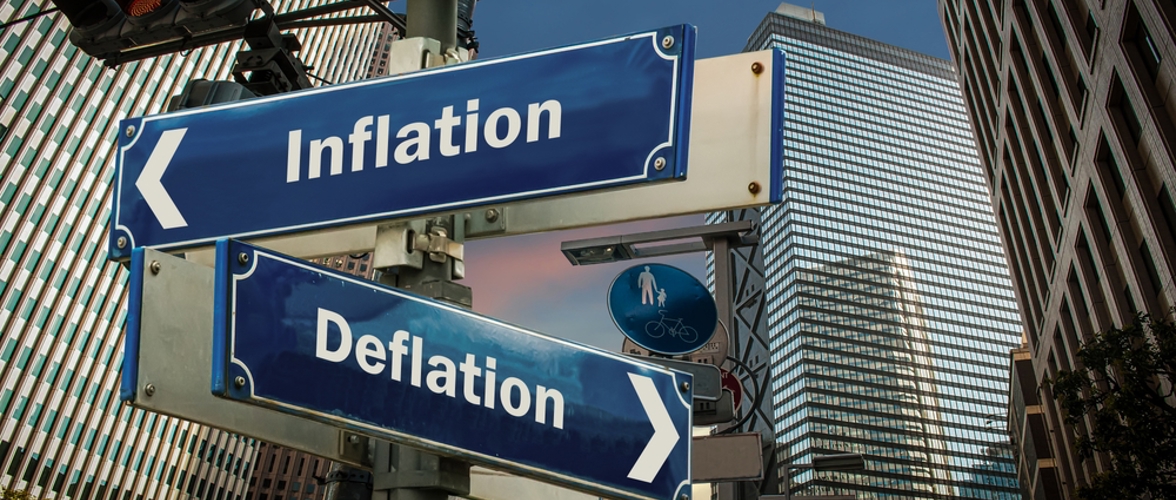Key Takeaways
- Deflation is an ongoing, broad decline in the prices of goods and services across the economy.
- While lower prices may seem like a good thing, ongoing deflation can limit consumer spending, stunt economic activity, reduce investment and cut wages.
- Breaking out of deflation requires targeted monetary and fiscal policy measures, but individual businesses can prepare for periods of economic downturn with smart strategic decisions.
Introduction
Inflation is a hot topic, but we don’t tend to hear much about its opposite force – deflation. Understanding deflation is crucial for strategic planners, business analysts and financial professionals. So, what is deflation in economics and what would it mean for your business? Let’s dive in.
What is deflation?
Put simply, deflation is the exact opposite of inflation. The economic phenomenon is a sustained, broad-based decline in the overall price of goods and services in an economy. It goes beyond just a one-time drop in prices and occurs when the inflation rate falls below 0%. This means that the economy is going through a period of falling prices. On the surface, lower prices seem like a net benefit, but they can have disastrous consequences for the economy if prices drop for a long time. Before we get into the consequences of deflation, let’s unpack how it occurs.
What causes deflation?
Several factors can cause deflation by pushing down the overall level of prices across the economy. Each factor has its own distinct impact. Many of these factors are tied to a decrease in the money supply, which is the total amount of money circulating in the economy at a given time.
Reduced demand
When consumers cut back on spending, the overall demand for goods and services decreases. This decrease in demand creates a surplus of products in the market, reducing prices as businesses try to stimulate sales.
Increased supply
An oversupply of goods and services in the market can surpass the level of demand. This oversupply of goods and services puts pressure on businesses to lower prices in order to clear their inventories and remain competitive.
Technological innovation
New technologies often bring about increased efficiency and productivity. This reduces production costs for businesses through automation or, more recently, artificial intelligence. As businesses save on costs, they can pass on these savings to consumers in the form of lower prices.
Government Policies
Certain fiscal and monetary policies can contribute to deflation. For instance, a government reducing public spending or a central bank increasing interest rates can slow economic activity and put downward pressure on prices.
The deflationary spiral
While lower prices can benefit consumers and save businesses money on inputs, sustained decreases can eventually lead to a downward spiral.
Imagine you want to buy a new laptop. You’ve done your research and identified the one you want, but you notice that laptop prices have been falling for the past few months. Instead of buying now, you decide to wait, expecting that the prices will drop even further in the near future. This is a perfectly logical decision on your part.
Now, multiply this behavior by millions of consumers. This collective delay in consumption reduces the overall demand for goods. As a result, businesses lower their prices further to stimulate sales. However, this often has the opposite effect. When consumers expect prices to keep falling, many delay their purchases even longer, resulting in a further fall in demand. This is how the economy ends up in a deflationary spiral.
How does deflation affect the economy?
Deflation has far-reaching implications for the broader economy. Ongoing deflation can stunt economic activity, potentially leading to a recession. This downward spiral can decrease investment, reduce wages, and increase debt burdens for individuals and households. Deflationary pressures can hinder central banks' efforts to stimulate economic growth, making it harder for policymakers to maintain price stability and foster sustainable development.
How does deflation affect businesses?
Deflation can create a difficult economic environment for businesses to navigate. As prices decrease, businesses may struggle to maintain profitability amid reduced consumer spending and investment. Additionally, deflation can increase the real value of debt, making it more difficult for businesses to repay loans.
Historical examples of deflation
Deflation in the US
The United States experienced a period of deep deflation in the 1930s during the Great Depression. Prices of goods and services plummeted and production output dropped significantly, contributing to economic hardship and stagnation. Sectors across the economy, from agriculture to manufacturing, felt the effects of deflation, plunging the economy into a recession and prolonging the recovery process.
Deflation in Japan
Japan in the 1990s is another notable example of a deflationary period. Following the burst of an economic bubble in 1991, Japan experienced a prolonged period of deflation, often referred to as the Lost Decade. During this time, prices fell continuously, causing a significant decrease in economic activity. Despite attempts by the Japanese government and central bank to stimulate the economy, deflation persisted for more than a decade. This led to a stagnation in wages, high unemployment, and a persistent state of economic uncertainty. Japan has continued to face periods of deflation throughout the 21st century.
How to manage deflation
To counteract deflation, central banks often implement monetary policies like lowering interest rates, increasing government spending or quantitative easing. While you can’t singlehandedly pull the economy out of deflation, you can develop strategies to help your business navigate economic downturns.

Diversification and innovation
Diversifying your product and service offerings can help your business meet changing consumer demands among both your existing customer base and prospects. Robust product development processes that focus on innovation and research will keep you ahead of your competition. Introducing new products or improving existing ones helps you provide more value to your customers and differentiate your business.
Operational efficiency and technological investment
Efficiency is key during periods of deflation. Streamlining your business processes and eliminating waste can significantly improve operational efficiency. This includes negotiating better deals with suppliers to reduce costs, which will be easier if you've built strong relationships with them. Investing in technology and automation can further increase productivity and decrease overhead expenses. These strategies will help you maintain profitability even when prices are falling.
Customer engagement
Customer loyalty becomes even more important during a prolonged economic downturn. If you haven’t already, make time to define and understand your business’s key customer personas. Understanding your customers wants, needs and pain points will help you provide exceptional service and personalized experiences that cater specifically to your markets. Implementing effective marketing and advertising campaigns can also play a vital role in maintaining your market share during challenging economic times. These strategies can help you retain your existing customer base and attract new buyers or clients.
Strategic planning and market expansion
Keeping an eye on economic indicators and trends allows you to anticipate deflationary risks and plan your strategies accordingly. This could involve adjusting your pricing strategies to remain competitive without compromising your business’s profitability. You might also consider seeking opportunities for strategic partnerships or acquisitions to expand your market reach, which can allow you to tap into new customer bases and increase your revenue streams.
Final Word
While individual businesses don’t have a lot of control over whether the economy is in deflation, you can take steps to ride out periods of economic downturn. Start by understanding the phenomenon so you can recognize the signs of deflation, then implement strategies to manage its effects and protect your business.









